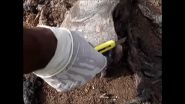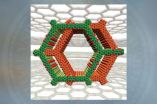(Press-News.org) Bottom Line: A postoperative pneumonia prevention program for patients in the surgical ward at a California Veterans Affairs hospital lowered the case rate for the condition, which can cause significant complications and increase the cost of care.
Author: Hadiza S. Kazaure, M.D., of the Stanford University School of Medicine, California, and colleagues.
Background: Pneumonia is a common infection that accounts for about 15 percent of all hospital-acquired infections and as much as 3.4 percent of complications among surgical patients.
How the Study Was Conducted: The study outlines the results (2008-2012) for a postoperative pneumonia prevention program for patients who were not on a mechanical ventilator in the hospital's surgical ward. The prevention program had several components, including ongoing education for surgical ward nursing staff on pneumonia prevention, coughing and deep-breathing exercises with incentive spirometer, twice daily oral hygiene with chlorhexidine, walking, sitting up to eat and elevated head-of-bed.
Results: Between 2008 and 2012, there were 18 cases of postoperative pneumonia among 4,099 at-risk hospitalized patients for a case rate of 0.44 percent. That is a 43.6 percent decrease from the hospital's preintervention rate of 0.78 percent. Pneumonia rates in all years were lower than the preintervention rate (0.25 percent, 0.50 percent, 0.58 percent, 0.68 percent and 0.13 percent in 2008-2012, respectively).
Discussion: "Despite the limitations listed earlier, our study supports the concept that successful and sustained reduction of pneumonia among postoperative patients requires multiple performance measures and unrelenting standardized quality improvement efforts."
(JAMA Surgery. Published online July 23, 2014. doi:10.1001/jamasurg.2014.1216. Available pre-embargo to the media at http://media.jamanetwork.com.)
Editor's Note: Please see the article for additional information, including other authors, author contributions and affiliations, financial disclosures, funding and support, etc.
Commentary: Preventing Postoperative Pneumonia
In a related commentary, Catherine E. Lewis, M.D., of the University of California, Los Angeles, writes: "Although encouraging, these findings should be interpreted with caution. The preintervention rate of pneumonia was 0.78 percent in the Veterans Affairs Palo Alto Health Care System and 2.56 percent in the ACS-NSQIP [American College of Surgeons National Surgical Quality Improvement Program] - a difference of 328 percent that is already of statistical significance. This remarkably low rate of pneumonia calls into question the adequacy of detection and reporting of pneumonia on their ward and also makes their finding of a significant difference between their postintervention and ACS-NSQIP rate of somewhat less consequence."
"Although the number of ward cases decreased from 13 to 3, the number of nonventilator-associated pneumonia intensive care unit cases increased from 4 to 17, and therefore, the reported decrease could be due to redistribution in the location of patients," Lewis continues.
"A third concern is that the authors did not evaluate changes in patient care or surgical technique that could have altered the incidence of postoperative pneumonia. … Despite these concerns, the authors should be commended for the development and implementation of a quality improvement measure aimed at decreasing the rate of postoperative pneumonia in a Veterans Affairs population," Lewis concludes.
(JAMA Surgery. Published online July 23, 2014. doi:10.1001/jamasurg.2014.1249. Available pre-embargo to the media at http://media.jamanetwork.com.)
Editor's Note: Please see the article for additional information, including other authors, author contributions and affiliations, financial disclosures, funding and support, etc.
INFORMATION:
Media Advisory: To contact corresponding author Sherry M. Wren, M.D., call Michelle L. Brandt at 650-723-0272 or email mbrandt@stanford.edu. To contact commentary author Catherine E. Lewis, M.D., call Roxanne Yamaguchi Moster at 310-794-2264 or email RMoster@mednet.ucla.edu or call Enrique Rivero at 310-794-2273 or email ERivero@mednet.ucla.edu.
Study examines postoperative pneumonia prevention program in surgical ward
2014-07-24
ELSE PRESS RELEASES FROM THIS DATE:
New regions of genetic material are involved in the development of colon cancer
2014-07-24
Most research on human cancer genes have been focused on the regions of the coding genome (exons) that are to be translated in the form of amino acids thus proteins. But just before each gene, there is a regulatory region or activator which controls the expression and activity of the adjacent gene. Until now, very little was known of the role exerted such DNA fragment in tumor development.
An article published today in Nature in collaboration with the group of Manel Esteller, Director of Epigenetics and Cancer Biology, Bellvitge Biomedical Research Institute (IDIBELL), ...
Nano-sized chip 'sniffs out' explosives far better than trained dogs
2014-07-24
Security forces worldwide rely on sophisticated equipment, trained personnel, and detection dogs to safeguard airports and other public areas against terrorist attacks. A revolutionary new electronic chip with nano-sized chemical sensors is about to make their job much easier.
The groundbreaking nanotechnology-inspired sensor, devised by Prof. Fernando Patolsky of Tel Aviv University 's School of Chemistry and Center for Nanoscience and Nanotechnology, and developed by the Herzliya company Tracense, picks up the scent of explosives molecules better than a detection dog's ...
Detecting concussion-related brain disease in its earliest stages
2014-07-24
Autopsies have shown that some high-profile athletes who suffered repeated blows to the head during their careers have unusual protein clumps in their brains. Those clumps suggest the athletes had a disease called chronic traumatic encephalopathy (CTE). Now, scientists are working on tests that might be able to detect CTE in its earliest stages, according to an article in Chemical & Engineering News (C&EN), the weekly news magazine of the American Chemical Society.
In the article, Lauren Wolf, a senior editor at C&EN, explains that many of these athletes struggled with ...
Dead-body-feeding larvae useful in forensic investigations
2014-07-24
VIDEO:
This image depicts Chrysomya megacephala larvae on decomposing fish.
Click here for more information.
Non-biting blow fly Chrysomya megacephala is commonly found in dead bodies and is used in forensic investigations to determine the time of death, referred to as the post mortem interval. A report of synanthropic derived form of C. megacephala from Tamil Nadu is provided for the first time based on morphological features and molecular characterization through generation ...
Nearly 50 years of lemur data now available online
2014-07-24
VIDEO:
Duke Lemur Center had made 48 years of primate data available online.
Click here for more information.
DURHAM, N.C. -- A 48-year archive of life history data for the world's largest and most diverse collection of endangered primates is now digital and available online. The Duke Lemur Center database allows visitors to view and download data for more than 3600 animals representing 27 species of lemurs, lorises and galagos -- distant primate cousins who predate monkeys ...
New mass map of a distant galaxy cluster is the most precise yet
2014-07-24
Astronomers using the NASA/ESA Hubble Space Telescope have mapped the mass within a galaxy cluster more precisely than ever before. Created using observations from Hubble's Frontier Fields observing programme, the map shows the amount and distribution of mass within MCS J0416.1-2403, a massive galaxy cluster found to be 160 trillion times the mass of the Sun. The detail in this mass map was made possible thanks to the unprecedented depth of data provided by new Hubble observations, and the cosmic phenomenon known as strong gravitational lensing.
Measuring the amount and ...
University of Delaware researcher describes new approach for creating organic zeolites
2014-07-24
Yushan Yan, Distinguished Professor of Engineering at the University of Delaware, is known worldwide for using nanomaterials to solve problems in energy engineering, environmental sustainability and electronics.
His early academic work focused on zeolites, porous rock with a well-defined, crystalline structure. At the atomic scale, their pore size is so precisely decided that zeolites can separate molecules with size differences of merely a fraction of an angstrom (one-tenth of a nanometer), making them useful to the chemical and petroleum industries as molecular sieves ...
Background TV can be bad for kids
2014-07-24
Parents, turn off the television when your children are with you. And when you do let them watch, make sure the programs stimulate their interest in learning.
That's the advice arising from University of Iowa researchers who examined the impact of television and parenting on children's social and emotional development. The researchers found that background television—when the TV is on in a room where a child is doing something other than watching—can divert a child's attention from play and learning. It also found that non-educational programs can negatively affect children's ...
Wireless home automation systems reveal more than you would think about user behavior
2014-07-24
This news release is available in German.
Home automation systems that control domestic lighting, heating, window blinds or door locks offer opportunities for third parties to intrude on the privacy of the inhabitants and gain considerable insight into their behavioral patterns. This is the conclusion reached by IT security expert Christoph Sorge and his research team at Saarland University. Even data transmitted from encrypted systems can provide information useful to potential burglars. Professor Sorge, who holds the juris Professorship in Legal Informatics ...
Natural products from plants protect skin during cancer radiotherapy
2014-07-24
Radiotherapy for cancer involves exposing the patient or their tumor more directly to ionizing radiation, such as gamma rays or X-rays. The radiation damages the cancer cells irreparably. Unfortunately, such radiation is also harmful to healthy tissue, particularly the skin over the site of the tumor, which is then at risk of hair loss, dermatological problems and even skin cancer. As such finding ways to protect the overlying skin are keenly sought.
Writing in the International Journal of Low Radiation, Faruck Lukmanul Hakkim of the University of Nizwa, Oman and Nagasaki ...





